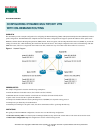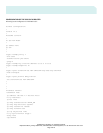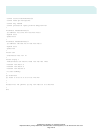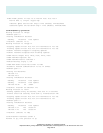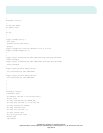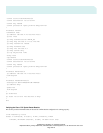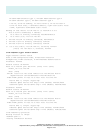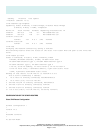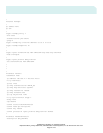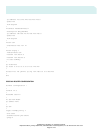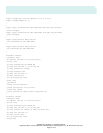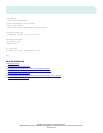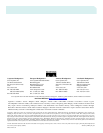
© 2005 Cisco Systems, Inc. All rights reserved.
Important notices, privacy statements, and trademarks of Cisco Systems, Inc. can be found on cisco.com.
Page 2 of 16
• This configuration guide uses private addresses only. When using private addresses and connecting to the Internet, an appropriate Network
Address Translation (NAT) or Port Address Translation (PAT) configuration is required to provide connectivity over the Internet.
• The ODR provides a default route only to the spoke, the configuration support hub and spoke topology; no split tunneling
PRECAUTIONS
Before configurations are made to any router, confirm the following:
• The spoke router can reach the DMVPN hub directly over the Internet.
• The DMVPN hub is configured and operational.
COMPONENTS
• Cisco IOS Software Release 12.3(11)T3(fc2)
• Cisco 831, 1751, 3725 and 3745 Routers
Figure 1 illustrates the network for the sample configuration.
The information presented in this document was created from devices in a specific lab environment. All devices started with a cleared (default)
configuration. It is imperative to understand the potential impact of any command before implementing it in a live network.
This configuration uses two DMVPN hub routers. Each hub router is configured with a separate DMVPN tunnel network (192.168.1.0/24 and
192.168.2.0/24). The first tunnel on the spokes is used for direct connectivity through the first DMVPN hub and the second tunnel on the spokes
is used for the second DMVPN hub. During normal operations with dual hubs, the spoke router load-balances the traffic between both hubs.
Connectivity between the spoke routers is provided through the hub routers in hub and spoke topology. During a failure, the ODR protocol will time
out the failed path, and it will use one active path to the active hub router.
Using ODR, the hub router learns about the remote networks using the CDP protocol. By default, CDP is disabled on the tunnel interface. To allow
the hub and spoke routers to exchange routes, CDP must be enabled on the tunnel interface. ODR allows for push of the default route from the hub
router to the spoke router. The hub router configuration only accepts spoke routers network ranges defined with the “distribute-list 101 in” in order
to prevent the risk of learning the DHCP public network of spoke router from the tunnel interface with ODR. All routing protocols should be
disabled on the spoke routers to activate ODR on the spoke routers.
By default, CDP sends updates every sixty seconds. This update interval may not be frequent enough to provide faster re-convergence of IP routes on
the hub router side of the network. A quicker re-convergence rate may be necessary if the spoke connects to one of several hub routers via
asynchronous interfaces such as modem lines.
ODR expects to receive periodic CDP updates, which contain IP prefix information. When ODR fails to receive updates for routes that it has
installed in the routing table, these ODR routes are first marked invalid and eventually removed from the routing table (by default, ODR routes are
marked invalid after 180 seconds and are removed from the routing table after 240 seconds). These defaults are based on the default CDP update
interval. Configuration changes made to either the CDP or ODR timers should be reflected through changes made to both.
For additional information about configuring ODR timers, refer to:
http://www.cisco.com/en/US/products/sw/iosswrel/ps1835/products_configuration_guide_chapter09186a00800ca75f.html#1000989



